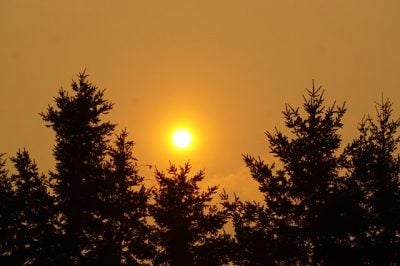Welcome to the New World of Wildfires

Featured image: The Pacific Northwest has been engulfed in wildfire smoke from Montana, British Columbia, Eastern Washington and Oregon for much of this summer. (Photo: Dahr Jamail)
When one envisions the US Pacific Northwest, one thinks of green ferns, moss-covered trees in Olympic National Park, or the Hoh Rainforest, where annual rainfall is measured in the hundreds of inches. Moisture, greenery, evergreens, abundant rivers. It’s a large part of the reason why I live here.
But thanks to abrupt anthropogenic climate disruption (ACD), this region is shifting at a rapid pace. On the Olympic Peninsula where I live, this has been the summer of wildfire smoke.
As I write this, Puget Sound, Seattle and the Olympic Peninsula, are all engulfed by thick wildfire smoke and ash from fires burning in Eastern Washington and Montana. A local Seattle weatherman remarked that he had “never seen a situation like this.”
Washington Gov. Jay Inslee declared a state of emergency for his entire state on Saturday September 2.
Smoke from various wildfires has been a near-constant in this part of the country for the past month. Roughly a week ago, we were enshrouded by smoke from multiple wildfires across Oregon, and before that, we spent nearly two weeks breathing in thick smoke from the over 1,000 wildfires that scorched British Columbia up the coast from us.
Stepping outside, the world appears a surreal yellow. The sun varies from not being visible, to emerging as a yellowish orange bulb even during the middle of the day. When it sets, it has often appeared blood red through the thick smoke.
NASA satellite photos show the smoke plume even reaching the East Coast.
Given past and recent scientific reports, this is apparently the world we, and much of the rest of the United States, had better prepare to live in from now on.
Extreme Heat, Extreme Drought
The smoke plume from all of these fires, at the time of this writing, extends from up into British Columbia all the way down into central Oregon.
A wildfire outside Portland has forced hundreds of residents to evacuate while it burned out of control in the Columbia River Gorge. That is just one of 81 wildfires burning across the US at the time of this writing, with 20 of those fires in Oregon alone.
Climate researchers have been warning us for a long time that increasing temperatures and more intense droughts will logically cause dramatic escalations in the number, heat and ferocity of wildfires.
A study published earlier this year showed that human-caused greenhouse gas emissions have increased the likelihood of extreme heat events across more than 80 percent of the planet.
Last fall, researchers published the results of a study that showed ACD accounted for approximately half of the increase in wildfire fuel aridity (forest dryness) in the Western US since just 1979, causing the area of the US West affected by forest fires to double in size since 1984.
According to Inside Climate News:
“Nine of the 10 worst fire seasons in the past 50 years have all happened since 2000, and 2015 was the worst fire season in U.S. history, surpassing 10 million acres for the first time on record. So far this year, wildfires in the US have burned 7.8 million acres, but the fire season is far from over. The average fire season is 78 days longer than it was in the 1970s and now lasts nearly seven months — beginning and extending beyond the typical heat of summer. By April of this year, wildfires had scorched more than 2 million acres in the US — nearly the average consumed in an entire fire season during the 1980s.”
Extreme Heat
When it comes to hot weather — and relatedly, fire — this has been a summer for the record books in the West. During the first week of September, San Francisco saw a stunning record high temperature of 106°F, amid a heatwave that saw 36.5 million Californians (98 percent of the state population) living under a heat advisory issued by the National Weather Service.
Earlier this month, Los Angeles saw its largest wildfire on record scorch 7,000 acres before rains from a remnant tropical storm helped firefighters get the upper hand.
Yale Environment 360 warned of this likelihood last December. The magazine, published by the Yale School of Forestry & Environmental Studies, reported that as the Arctic continues to warm twice as fast as the rest of the globe, winds in the upper atmosphere would be pulled into the polar zone and cause the jet stream to become wavier during extreme weather patterns. This is a more technical explanation for the fact that, as another study warned in March, these new weather patterns will generate record heatwaves and wildfires — precisely what we are seeing now across the West.
And given that there are no serious, large-scale ACD mitigation efforts happening, least of all within the United States, we can count on these trends to amplify and worsen with time.
Dahr Jamail, a Truthout staff reporter, is the author of The Will to Resist: Soldiers Who Refuse to Fight in Iraq and Afghanistan (Haymarket Books, 2009), and Beyond the Green Zone: Dispatches From an Unembedded Journalist in Occupied Iraq (Haymarket Books, 2007). Jamail reported from Iraq for more than a year, as well as from Lebanon, Syria, Jordan and Turkey over the last 10 years, and has won the Martha Gellhorn Award for Investigative Journalism, among other awards.
Copyright, Truthout. Reprinted with permission.

